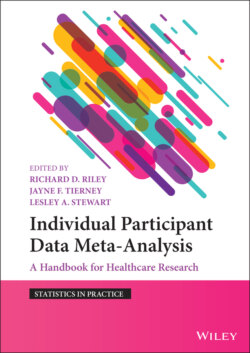Читать книгу Individual Participant Data Meta-Analysis - Группа авторов - Страница 36
3.3 Developing a Project Scope
ОглавлениеDeveloping a project scope is a good way of refining and developing the research question to be addressed, and rapidly prototyping key aspects of project design. A scope should be brief, perhaps around two to three pages in length, and capture the key aims and methods of the project including: the proposed inclusion and exclusion criteria, the main and other outcomes, and any important clinical subgroups and participant‐level variables of interest, such as those to be examined as potential effect modifiers. Careful specification of proposed inclusion and exclusion criteria in terms of the PICOS (Population, Intervention, Comparator, Outcomes, Study design) framework at the outset, and reference to them throughout the IPD meta‐analysis project, should ensure that the final results are clinically relevant and applicable as intended. If a collaborative approach is adopted, it may also be helpful to outline the terms of collaboration such as the publication policy (e.g. whether group or named authorship will be used, and how many group members/authors are allowed per trial), data safeguarding arrangements, and responsibilities of group membership. An example extract from the scope of an IPD meta‐analysis project is given in Box 3.2.
Feedback on a draft scope can be sought from a range of relevant stakeholders and experts, who may find it easier and be more inclined to comment on a short document than a full protocol, enabling the scope to be refined rapidly and iteratively. It can also be circulated to potential collaborators at an early stage of project development, perhaps when sounding out potential willingness to collaborate in the project, and may also serve as a basis for developing a funding application and the project protocol.
